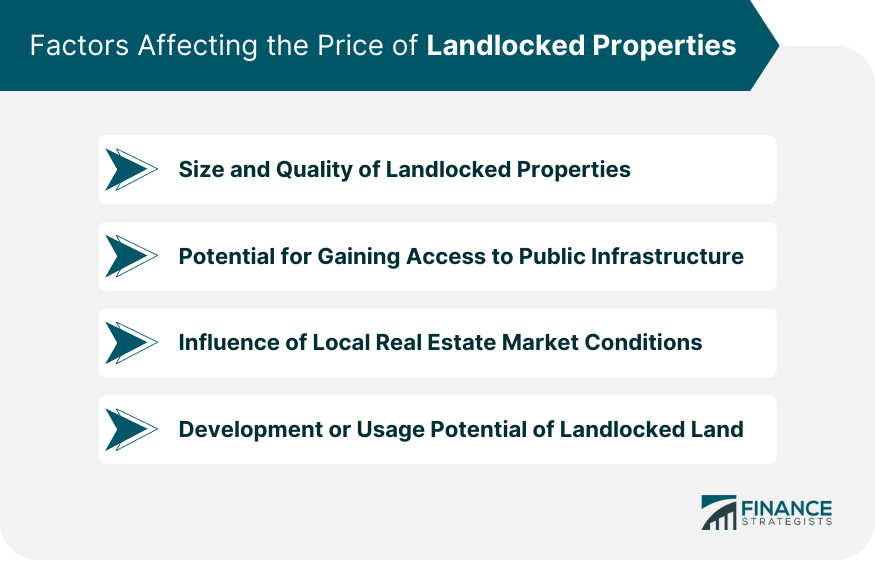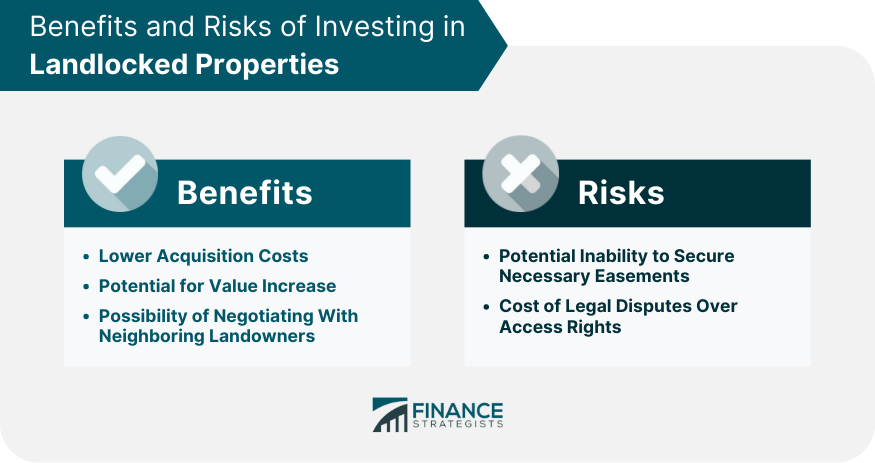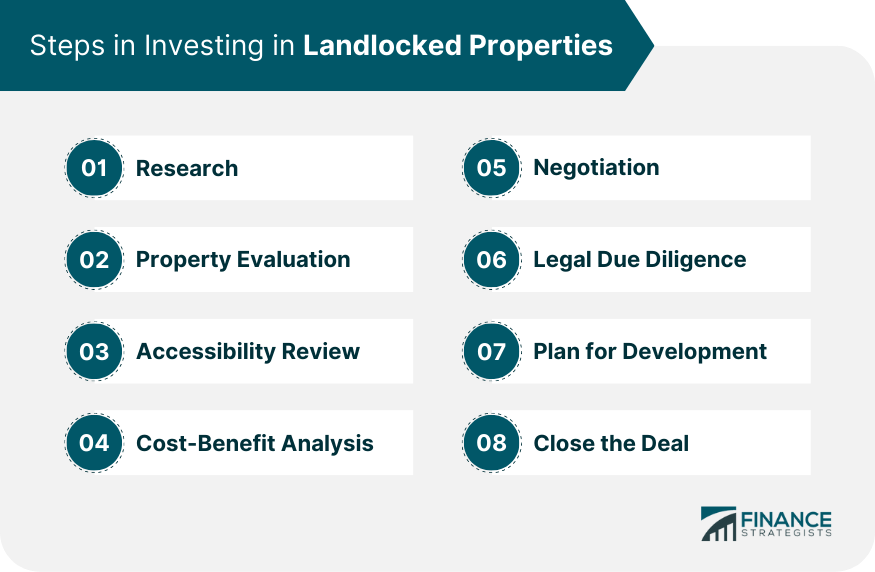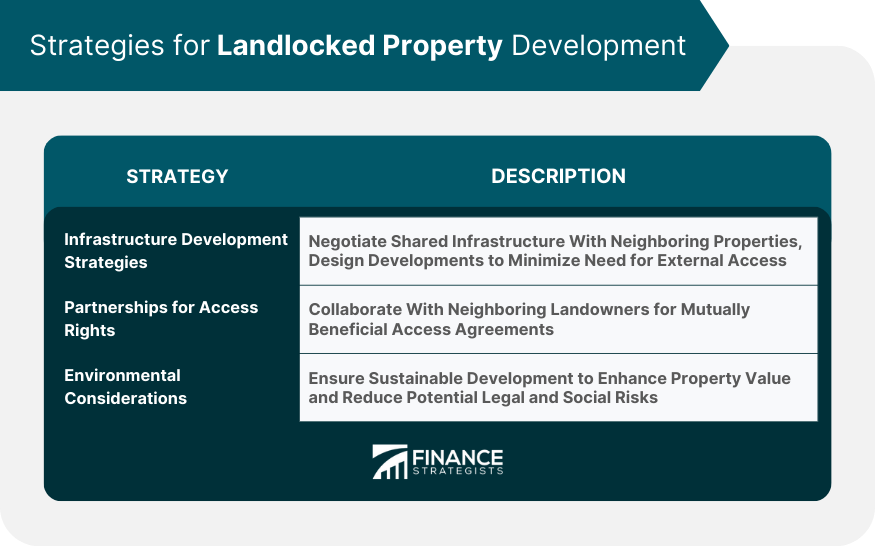"Landlocked" refers to a geographic term describing a region or country entirely surrounded by land, without access to open sea. This physical condition inherently impacts its trade, economy, and development. Landlocked areas face challenges due to the lack of direct maritime access, which complicates transport of goods and services, often leading to higher costs and slower economic growth. However, such regions can also harbor unique ecosystems, cultures, and resources. Understanding the concept of being landlocked deepens appreciation of global geography, economic disparities, and developmental dynamics. Landlocked underlines the interdependence between geography and socio-economic development, enriching one's comprehension of the world's complex matrix. The nature and extent of the landlocking can significantly affect the market value of a property. This can range from minor inconvenience to major obstruction in property usage. For instance, a property could be landlocked but located close to a public road, thus providing the potential for easy access if an easement can be negotiated. Conversely, a property might be completely isolated, making access considerably more difficult and reducing the property's value even further. The willingness of neighboring property owners to grant easements, or legal rights to use a path through their property, can play a crucial role in the valuation of landlocked properties. If neighbors are amenable to granting such access, it increases the potential for the landlocked property to be developed and consequently raises its market value. On the other hand, if the neighboring owners are unwilling to provide easements, the property may remain inaccessible, negatively impacting its value. The development potential of a landlocked property is another important consideration. If the land can be developed for a purpose that doesn't require direct access to public infrastructure, such as a solar farm or a nature reserve, its value might be higher than expected. However, if the property is unsuitable for such uses, its market value will likely be diminished. A larger landlocked property or a property with rich resources, such as fertile soil or valuable minerals, can still hold significant value despite being landlocked. Meanwhile, smaller properties or those lacking in such attributes may face a steeper decline in market value. The possibility of securing access to public infrastructure greatly affects a landlocked property's value. This often requires negotiating with neighboring property owners for easements, but in some cases, it might also involve working with local governments or agencies. Local real estate market conditions also play a significant role. For instance, in a hot real estate market, even landlocked properties might fetch reasonable prices due to high demand. Conversely, in a sluggish market, these properties may be even harder to sell. The potential uses or development of the landlocked property can also have a significant impact on its market value. For instance, if the property can be used for agriculture, forestry, or alternative energy projects, it may still have considerable value. If, however, it lacks such potential uses, its value may be significantly reduced. Easements are crucial for landlocked properties. An easement grants the right to use another person's land for a specified purpose. There are several types of easements, such as utility easements and right-of-way easements. Different types of easements come into play with landlocked properties. A right-of-way easement, for instance, allows a property owner to cross another's property to access their land. A utility easement allows utility companies to install and maintain infrastructure like power lines and pipelines on private property. For landlocked properties, easements often provide the only legal means of access. Thus, the negotiation, establishment, and enforcement of easements can significantly affect the value and utility of a landlocked property. Some benefits can include lower acquisition costs, the potential for value increase through securing access rights, or the possibility of negotiating with neighboring landowners for mutually beneficial arrangements. Risks include the potential inability to secure necessary easements, leading to a property that is difficult to develop or sell. The cost of legal disputes over access rights can also be significant. Investing in landlocked properties may require a unique approach given their unique challenges and opportunities. Here are the key steps: Research: Study the region's development plans, transport accessibility, and local laws. Property Evaluation: Inspect the land for environmental and topographical issues, and assess the potential for development. Accessibility Review: Since the property lacks direct road access, understand the legal right-of-way provisions for accessing the property. Cost-Benefit Analysis: Evaluate the return on investment, considering potential higher costs due to limited accessibility. Negotiation: Use the landlocked status as a bargaining chip to negotiate a lower price. Legal Due Diligence: Consult with a real estate attorney to avoid potential legal issues, especially around right-of-way. Plan for Development: If the land is to be developed, create a strategic plan that considers the additional logistics and costs. Close the Deal: Once all factors are satisfactory, proceed with the purchase. When developing landlocked property, strategies might include negotiating shared infrastructure with neighboring properties, designing developments to minimize the need for external access, or even using alternative forms of access, such as air or water transport, where possible. Creating partnerships with neighboring landowners can be beneficial. For example, a shared driveway agreement can provide access while reducing costs for all parties. The development of any property, including landlocked ones, must consider environmental impacts. Ensuring sustainable development can enhance the property's value while reducing potential legal and social risks. Government policies can affect the value and development potential of landlocked properties. These may include zoning regulations, building codes, and policies on easements and access rights. In some jurisdictions, government programs may assist owners of landlocked properties in securing access or in developing their properties. This assistance can take various forms, such as financial incentives or assistance in dispute resolution. Technological advancements, such as digital mapping and GIS systems, are becoming increasingly important in managing and developing landlocked properties. These tools can help property owners visualize access routes, understand the topography and other site characteristics, and plan development strategies. Similarly, communication and negotiation tools can streamline the process of securing easements and resolving disputes. Climate change may impact landlocked properties, particularly those in areas at risk of flooding or other climate-related risks. Property owners must consider these risks in their development and investment strategies. Increasing urbanization may increase the demand for landlocked properties in urban areas where undeveloped land is scarce. Investing in landlocked properties presents a unique blend of challenges and opportunities, shaped by geography, legislation, and market dynamics. The negotiation of access rights, particularly through easements, is crucial for maximizing the property's value and utility. Technology, including digital mapping and GIS systems, can aid in managing these properties and planning development strategies. Economic trends like urbanization and challenges such as climate change also play crucial roles in the future prospects of these properties. Government policies and programs can influence the feasibility of development and may offer assistance to landlocked property owners. Thus, a strategic approach, informed by thorough research, careful negotiation, and innovative development tactics, can turn landlocked properties into profitable investments.What Is Landlocked?
Market Value of Landlocked Properties
Impact of Landlocking on Property Value
Role of Neighboring Property Owners in Granting Easements
Development Potential of Landlocked Properties
Factors Affecting the Price of Landlocked Properties
Size and Quality of Landlocked Properties
Potential for Gaining Access to Public Infrastructure
Influence of Local Real Estate Market Conditions
Development or Usage Potential of Landlocked Land

Legal Aspects of Landlocked Properties
Understanding Easements
Types of Easements
Role of Easements in Landlocked Properties
Investing in Landlocked Properties
Potential Benefits
Risks and Challenges

Steps in Investing in Landlocked Properties

Strategies for Landlocked Property Development
Infrastructure Development Strategies
Partnerships for Access Rights
Environmental Considerations

Landlocked Properties and the Role of Government
Public Policies Related to Landlocked Properties
Government Assistance Programs
Impact of Technological Advancements on Landlocked Properties
Digital Mapping and Landlocked Properties
Technology in Negotiating Access to Landlocked Properties
Future Trends and Predictions for Landlocked Properties
Effects of Climate Change on Landlocked Properties
Impact of Urbanization Trends
Final Thoughts
Landlocked FAQs
In financial terms, a "landlocked" property refers to a piece of real estate that does not have direct access to a public road or other forms of public right-of-way. This can pose challenges in terms of accessibility, which can affect the property's value and potential for development.
Factors that affect the market value of landlocked properties include the size and quality of the land, the potential for gaining access, local real estate market conditions, and the property's potential for development or usage. The presence or absence of easement rights is also a crucial determinant of value.
Easements, or legal provisions allowing a property owner to use a portion of another's property for a specific purpose, often provide the only legal means of access to landlocked properties. Therefore, the establishment, negotiation, and enforcement of easements can significantly impact a landlocked property's value and usability.
Investing in landlocked properties can offer unique opportunities, despite the challenges. Strategies include thorough due diligence on access rights, negotiating easement agreements, and assessing the property's potential for use and development. Partnerships with neighboring landowners can also be beneficial.
Technological advancements can have significant impacts on landlocked properties. For instance, digital mapping and Geographic Information System (GIS) tools can help visualize access routes and plan development strategies. Additionally, technology can aid in negotiating access to landlocked properties and resolving disputes.
True Tamplin is a published author, public speaker, CEO of UpDigital, and founder of Finance Strategists.
True is a Certified Educator in Personal Finance (CEPF®), author of The Handy Financial Ratios Guide, a member of the Society for Advancing Business Editing and Writing, contributes to his financial education site, Finance Strategists, and has spoken to various financial communities such as the CFA Institute, as well as university students like his Alma mater, Biola University, where he received a bachelor of science in business and data analytics.
To learn more about True, visit his personal website or view his author profiles on Amazon, Nasdaq and Forbes.











